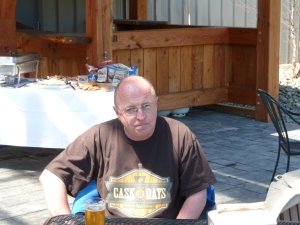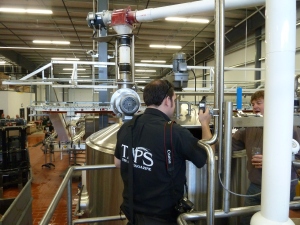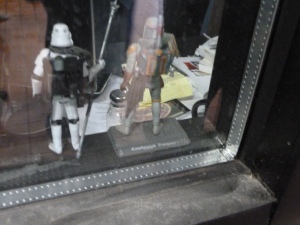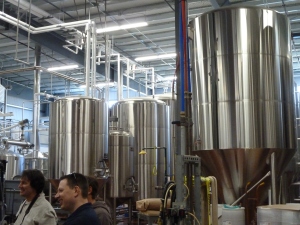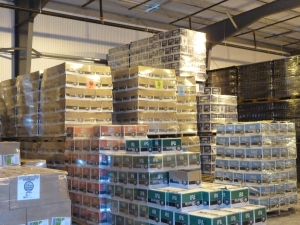While my editor at The Sun would probably be shocked to learn that I’m covering the international beat, it was my pleasure last Saturday to get up at oh-dark-thirty and accept an invitation on the behalf of Roland and Russell (Thanks, guys!) to visit Southern Tier in Lakewood, New York. Now, I’m not exactly a ball of fire at the breakfast table, so getting to the departure point involved great lashings of coffee.
I was lucky enough to get to sit next to my friend Doug on the Bus Tours to New York from Saint John NB. I mentioned Doug last year at about this time in reference to choosing which beers to try at Mondial. He’s developed something of a mental warehouse over the years on a number of subjects and isn’t shy about sharing his thoughts, which makes eight hours more or less fly past. I’ll skip the details of the journey except to remark that bus trips, if they are long enough, never really advance past the way that they were in grade six. There will be no bathroom. People will rediscover their inability to sleep sitting up and end up sprawled all over the aisle. Some hapless goon will have had the fiesta platter the night before to the chagrin of all passengers within six rows. It’s a very effective way of ensuring that enthusiasm builds for arrival at your destination; also a compelling argument for windows that roll down.
And so it was, with a small and slightly road weary cheer, that we pulled into the Southern Tier parking lot in time for lunch.
It’s hard to write about the Southern Tier operation without a certain amount of frustration if you’re an observer of the Ontario beer scene. I had done a little cursory research on the brewery and their offerings prior to the trip and it turns out that there’s a beer that they only make for the area that they’re in: Chautauqua Brew. It is, I think, an acknowledgement of the fact that breweries need to make things that people want to drink. It’s a lawnmower beer and is apparently only outsold by Busch Light in the area around the brewery.
I started with that sample, and as light bodied refreshing crowd pleasers go, it’s a fine beer. It’s just that it’s not the kind of thing they’re known for in Ontario. We’ve had the IPA, which is still listed in the LCBO, and the Pumking, Choklat and Crème Brulee beers. If you’re from Ontario, it’s easy to get the impression that they make large, full flavoured world beaters exclusively. Not so. They brew a full range of beers: Pale Ale, Porter and a handful of wheat beers in addition to the imperial series and a number of oaked beers.
All of the ones I tried, without exception, are standalone beers. One of the things I’ve noticed about the states is that a lot of the beers that came out of brewpubs in the states are sort of designed to go with food. They’re versatile in that respect, in that they can go with more than one dish. The flavours can become somewhat muddled because of this, or are intentionally blunted somewhat. Look at, say, UBU from Lake Placid. Good beer, but with versatility of function. The Southern Tier beers are seemingly designed with an exclusivity of purpose: To excel on their own.
I’ll say this for them. If you dislike one of their beers, it’s probably going to be because you dislike the style and not because of an intrinsic quality of the brew. I, for instance, didn’t like the Hopsun or 422 wheat beers. I can’t really hold that against them because they’re still well made.
I think this level of design and execution probably stems from the fact that these guys are nerds. Huge nerds. This is the window of the office that looks out onto the brewery. Yes. That’s a Boba Fett action figure.
Matt, the owner, was full of useful information. Southern Tier is 3rd in the US in terms of distribution within 300 miles of the brewery. Their production has expanded massively over the last three years, from 18000 barrels to 30000 to 60000. Their bottling line does 10000 bottles an hour. Consider, momentarily, that Creemore which is a big deal in Ontario produces 50000 hectolitres a year, or about 42,600 barrels (so says google, almighty conversion overlord.)
What exactly am I meant to do mentally with this information besides go and have a bit of a sulk? I’ve never seen a brewery this size with this amount of diversity before. I’m used to thinking in terms of much smaller volumes. 50 litres, mostly. 5 hectolitres at a time tops. How the hell do you get to the point as a brewery where creating an established line of imperial beers and quality standards on your own terms is possible? I have no idea, but I’ve come away with some impressions.
The first among them is that Southern Tier relies almost entirely on the quality of their brews to spread their reputation. The labeling is more or less limited to a standard font on a colorful background. For the imperial series, they include a graphic that fits with that conveys not only the identity of the beer, but part of the thought process behind it: A red tractor, a smiling Jack O’Lantern, a horse with a feedbag or a hop with a crown. Minimal. Not much pretension. Just a quality product.
Secondly, the tour is completely transparent: Here’s what we’re doing. That’s where we store things. Ingredient storage is through there. I haven’t ever seen that many hops in one place. The artificial flavourings aren’t hidden out of sight somewhere at the back of cold storage. I was about to comment disparagingly about the fact that there was artificial chocolate flavouring, but as Doug pointed out to me, you can’t really argue with the results.
Mostly, the impression that I came away with was that Southern Tier has succeeded basically because of their virtuosity at brewing and their justified confidence in their products. Much of the time in Ontario, there’s concern about brewing beers that are too flavourful; that the market won’t accommodate the decision to be interesting. It’s nice to see a situation where a brewery can succeed by designing the best beer it’s possible for them to make and then selling it.
So, while it’s a lovely modern brewery with all sorts of shiny metal and moving parts, I’m not sure what I’m supposed to do with this information. If anything, the knowledge that it’s possible to succeed as a brewery based mostly on skill and competence is a good motivator.
It should also provide motivation for the Ontario brewers who will no doubt have to compete with them for draft lines come December. It looks as though there are plans afoot to bring them into the province. I don’t know which beer it will be. Maybe an imperial. Maybe part of their regular lineup. It doesn’t really matter, since they’re all good.
